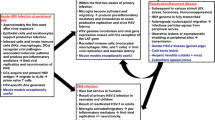Summary
Herpes-T virus was isolated from 2 of 4 clinically ill squirrel monkeys. The clinical manifestations of the disease in the monkeys was characterized by oral and labial lesions. From one of two animals sacrificed for histopathological examination, Herpes-T virus was isolated from the tongue and salivary gland. Herpes-T was isolated from the oral swab of one of the two live monkeys on the day of arrival in our laboratory and again on the 4th day. The anal swabs collected from both these monkeys failed to yield virus. The sera of these monkeys collected on the day of arrival showed a neutralization index (NI) of 1.0 and 1.5 against Herpes-T virus. The convalescent sera, collected two weeks later, showed a NI of 3.5 and 4.0 respectively for the same virus. Clear plaques ranging in size from 2 to 3 mm were produced in chick fibroblast and rabbit kidney primary monolayers.
This is the first report of the isolation of Herpes-T virus from naturally infected squirrel monkeys. This data further supports that the squirrel monkey is a natural host of Herpes-T virus.
Similar content being viewed by others
References
Dienhardt, F., andJ. Dienhardt: Platyrrhine monkeys in medical research., p. 127–152 (1966).R. N. T. W. Fiennes (ed.), Recent Advances in Comp. MM. Academic Press, New York.
King, N. W., R. D. Hunt, M. D. Daniel, andL. V. Meléndez: Overt Herpes-T infection in squirrel monkeys (Saimiri sciureus). Accepted for publication in Lab. Anim. Care (1967).
Holmes, A. W., R. G. Caldwell, R. E. Dedmon, andF. Dienhardt: Isolation and characterization of a new Herpes virus. J. Immunol.92, 602–610 (1964).
Holmes, A. W., J. A. Devine, E. Nowakowski, andF. Dienhardt: The epidemiology of a Herpes virus infection of New World monkeys. J. Immunol.96, 668–671 (1966).
Hunt, R. D., andL. V. Meléndez: Spontaneous Herpes-T infection in the owl monkey (Aotus trivirgatus). Pathol. Veterinaria3, 1–26 (1966).
Meléndez, L. V.: A Herpes virus from Sand Rat (Psammomys obesus). Accepted for publication. Lab. Anim. Care (1966).
Meléndez, L. V., R. D. Hunt, F. G. Garcia, andB. F. Trum: A latent Herpes-T infection inSaimiri seiureus (squirrel monkey). P. 363–366 (1966).R. N. T. W. Fiennes (ed.), Recent Advances in Comp. Med. New York: Academic Press.
Melnick, J. L., M. Midulla, I. Wimberly, J. G. Barrera-Oro, andB. M. Levy: A new member of the Herpes virus group isolated from South American marmosets. J. Immunol.92, 596–601 (1964).
Temin, H. M.: Control of cellular morphology in embryonic cells infected with Rous Sarcoma virus in vitro. Virology10, 182–197 (1960).
Author information
Authors and Affiliations
Rights and permissions
About this article
Cite this article
Daniel, M.D., Karpas, A., Meléndez, L.V. et al. Isolation of Herpes-T virus from a spontaneous disease in squirrel monkeys (Saimiri sciureus). Archiv f Virusforschung 22, 324–331 (1967). https://doi.org/10.1007/BF01242953
Received:
Issue Date:
DOI: https://doi.org/10.1007/BF01242953




